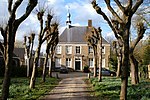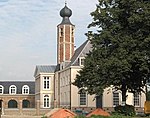Sint-Michielsgestel (municipality)
Municipalities of North BrabantPages including recorded pronunciationsPages with Dutch IPAPopulated places in North BrabantSint-Michielsgestel

Sint-Michielsgestel (Dutch pronunciation: [ˈsɪnt miˌxilsˈxɛstəl] ) is a municipality in the southern part of the Netherlands. It is named for the village of Sint-Michielsgestel located within its boundaries.
Excerpt from the Wikipedia article Sint-Michielsgestel (municipality) (License: CC BY-SA 3.0, Authors, Images).Sint-Michielsgestel (municipality)
Laantje Zegenwerp, Sint-Michielsgestel
Geographical coordinates (GPS) Address Nearby Places Show on map
Geographical coordinates (GPS)
| Latitude | Longitude |
|---|---|
| N 51.633333333333 ° | E 5.35 ° |
Address
Laantje Zegenwerp
5271 BN Sint-Michielsgestel
North Brabant, Netherlands
Open on Google Maps










